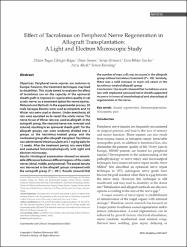| dc.contributor.author | Cilingir-Kaya, Ozlem Tugce | |
| dc.contributor.author | Sümer, Onur | |
| dc.contributor.author | Sirvanci, Serap | |
| dc.contributor.author | Gurler, Esra Bihter | |
| dc.contributor.author | Akcal, Arzu | |
| dc.contributor.author | Karsidag, Semra | |
| dc.date.accessioned | 2023-12-05T07:11:36Z | |
| dc.date.available | 2023-12-05T07:11:36Z | |
| dc.date.issued | 2021 | en_US |
| dc.identifier.citation | Cilingir-Kaya, O. T., Sumer, O., Sirvanci, S., Gurler, E. B., Akcal, A., & Karsidag, S. (2021). Effect of Tacrolimus on Peripheral Nerve Regeneration in Allograft Transplantation: A Light and Electron Microscopic Study. Experimental and clinical transplantation : official journal of the Middle East Society for Organ Transplantation, 19(12), 1322–1327. https://doi.org/10.6002/ect.2021.0017 | en_US |
| dc.identifier.uri | https://hdl.handle.net/20.500.12900/215 | |
| dc.description.abstract | Objectives: Peripheral nerve injuries are common in Europe; however, the treatment techniques may lead to disabilities. This study aimed to evaluate the effect of tacrolimus use on the capacity of the epineural sheath graft to improve its regeneration quality in rat sciatic nerves as a treatment option for nerve injuries.
Materials and Methods: In the experimental process, 30 male Sprague Dawley were used as recipients and 10 Wistar rats were used as donors. Under anesthesia, all rats were operated on to resect the sciatic nerve. The nerve tissue of Wistar rats was used as allograft. In the autograft group, the resected nerve was reversed and sutured, resulting in an epineural sheath graft. For the allograft groups, rats were randomly divided into 2 groups as the tacrolimus-treated group and the nontreated group after allograft transplant. Tacrolimus was administered intramuscularly at 0.1 mg/kg daily for 12 weeks. After the treatment period, rats were killed and evaluated histomorphologically with light and electron microscopy.
Results: Histological examination showed no remarkable differences between different regions of the sciatic nerves (distal, middle, and proximal). The axonal density was decreased in the allograft groups compared with the autograft group (P < .001). Results showed that the number of mast cells was increased in the allograft group without tacrolimus treatment (P < .05). Similarly, there was a mild increase in mast cell count in the tacrolimus-treated allograft group.
Conclusions: Our results showed that tacrolimus use in rats with implanted epineural nerve sheath supported recovery in terms of morphological and physiological regeneration of the nerve. | en_US |
| dc.language.iso | eng | en_US |
| dc.publisher | Baskent Unıv | en_US |
| dc.relation.isversionof | https://doi.org/10.6002/ect.2021.0017 | en_US |
| dc.rights | info:eu-repo/semantics/openAccess | en_US |
| dc.subject | Aksonal rejenerasyon | en_US |
| dc.subject | Axonal regeneration | en_US |
| dc.subject | İmmünosupresyon | en_US |
| dc.subject | Immunosuppression | en_US |
| dc.subject | Nöropatik ağrı | en_US |
| dc.subject | Neuropathic pain | en_US |
| dc.title | Effect of Tacrolimus on Peripheral Nerve Regeneration in Allograft Transplantation: A Light and Electron Microscopic Study | en_US |
| dc.type | article | en_US |
| dc.department | İstanbul Atlas Üniversitesi, Tıp Fakültesi, Temel Tıp Bilimleri Bölümü | en_US |
| dc.authorid | 0000-0001-8259-521X | en_US |
| dc.contributor.institutionauthor | Gurler, Esra Bihter | |
| dc.identifier.volume | 19 | en_US |
| dc.identifier.issue | 12 | en_US |
| dc.identifier.startpage | 1322 | en_US |
| dc.identifier.endpage | 1327 | en_US |
| dc.relation.journal | EXPERIMENTAL AND CLINICAL TRANSPLANTATION | en_US |
| dc.relation.publicationcategory | Makale - Uluslararası Hakemli Dergi - Kurum Öğretim Elemanı | en_US |

















